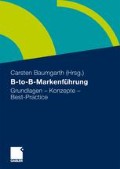Abstract
Im Zuge der Informationsüberflutung kämpfen Marken zunehmend mit der Überwindung der selektiven Wahrnehmung durch den Konsumenten. Ein zukunftsweisender Weg zu einer höheren Aufmerksamkeit ist die Bündelung starker Marken. Das Ingredient Branding stellte eine besondere Form der Markenkooperation dar: Eine häufig bereits bestehende Marke erfährt eine weitere Markierung durch die Kennzeichnung von Vorprodukten. Bekannte Beispiele hierfür sind Intel und GORE-TEX®. Von besonderem Interesse beim Ingredient Branding sind die verschiedenen Zielsetzungen von Hostbrand und Ingredient Brand, woraus sich unterschiedliche Erfolgsfaktoren der Umsetzung ableiten lassen.
Access this chapter
Tax calculation will be finalised at checkout
Purchases are for personal use only
Preview
Unable to display preview. Download preview PDF.
Literatur
Aaker, D. A. (1992): Management des Markenwerts, Frankfurt a. M.
Backhaus, K.; Schröder, J.; Perrey, J. (2002): B2B-Märkte, in: Absatzwirtschaft, 45. Jg., H. 11, S. 48–54.
Baumgarth, C. (1998): Ingredient Branding, Arbeitspapier des Lehrstuhls für Marketing der Universität Siegen, Siegen.
Baumgarth, C. (2003): Wirkungen des Co-Brandings, Wiesbaden.
Baumgarth, C. (2009): Kommunikationspolitik für Ingredient Brands, in: Aufbruch, Hrsg.: Mattmüller, R.; Michael, B. M.; Tunder, R., München, S. 132–147.
Binder, C. U. (1996): Brand Alliances, in: Absatzwirtschaft, 39. Jg., H. 4, S. 54–63.
Bugdahl, V. (1996): Ingredient Branding, in: Markenartikel, 58. Jg., H. 3, S. 110–113.
Chur, W.; Riesner, J. (2004): Marketing in der Automobilzulieferindustrie, in: Handbuch Industriegütermarketing, Hrsg.: Backhaus, K.; Voeth, M., Wiesbaden, S. 1143–1170.
Corey, E. R. (1962): Industrial Marketing, New Jersey.
Esch, F.-R. (2006): Markenmanagement, in: Wirtschafts-Lexikon, Hrsg.: Handelsblatt, Bd. 7, Stuttgart, S. 3629–3638.
Esch, F.-R.; Honal, A. (2009): Ingredient Branding als Strategieoption für Zulieferunternehmen im Rahmen des Markenmanagements, in: Aufbruch, Hrsg.: Mattmüller, R.; Michael, B. M.; Tunder, R., München, S. 60–87.
Esch, T.; Stein, M. (2001): Ingredient Branding, in: planung & analyse, 28. Jg., H. 1, S. 64–68.
Freter, H.; Baumgarth, C. (2005): Ingredient Branding, in: Moderne Markenführung, Hrsg.: Esch, F.-R., 4. Aufl., Wiesbaden, S. 455–480.
Haller, T. (2001): Ingredient Branding, in: Textil Zeitung, o. Jg., H. 33, S. 21.
Hertzberg, W. (1963): Markenwerbung für einen Kunststoff, in: Absatzwirtschaft, 6. Jg., H. 10, S. 732–736.
Keller, K. L. (1993): Conceptualizing, Measuring, and Managing Customer-Based Brand Equity, in: Journal of Marketing, 57. Jg., H. 1, S. 1–22.
Kemper, A. C. (2000): Strategische Markenpolitik im Investitionsgüterbereich, Lohmar, Köln.
Kleinaltenkamp, M. (2001): Ingredient Branding, in: Erfolgsfaktor Marke, Hrsg.: Köhler, R.; Majer, W.; Wiezorek, H., München, S. 261–270.
Kleinaltenkamp, M. (2009): Ingredient Branding bei Industriegütern, in: Aufbruch, Hrsg.: Mattmüller, R.; Michael, B. M.; Tunder, R., München, S. 148–165.
Kleinaltenkamp, M.; Rudolph, M. (1999): Mehrstufiges Marketing, in: Strategisches Business-to-Business-Marketing, Hrsg.: Kleinaltenkamp, M.; Plinke, W., Berlin, S. 283–319.
Krüger, W.; Homp, C. (1997): Kernkompetenz-Management, Wiesbaden.
Mattmüller, R. (2006): Integrativ-Prozessuales Marketing, 3. Aufl., Wiesbaden.
Mattmüller, R.; Irion, T.; Götting P. (2009): Ingredient Branding, in: Aufbruch, Hrsg.: Mattmüller, R.; Michael, B. M.; Tunder, R., München, S. 2–23.
Meffert, H.; Burmann, C.; Koers, M. (2005): Stellenwert und Gegenstand des Markenmanagements, in: Markenmanagement, Hrsg.: Meffert, H.; Burmann, C.; Koers, M., 2. Aufl., Wiesbaden, S. 3–17.
Meyer, P. W. (1978): Markenspezifisches Herstellermarketing, in: Markenartikel heute, o. Hrsg., Wiesbaden, S. 159–181.
Norris, D. G. (1992): Ingredient Branding, in: The Journal of Consumer Marketing, 9. Jg., H. 3, S. 19–31.
Pförtsch, W.; Müller, I. (2006): Die Marke in der Marke, Berlin.
Pförtsch, W.; Schmid, M. (2005): B2B-Markenmanagement, München.
Schramm, A.; Götting, P. (2009): Inside McDonald’s, in: Aufbruch, Hrsg.: Mattmüller, R.; Michael, B. M.; Tunder, R., München, S. 270–287.
Simon, H.; Sebastian, K.-H. (1995): Ingredient Branding, in: Absatzwirtschaft, 38. Jg., H. 6, S. 42–48.
Wendler, U.; Götting, P. (2009): Henkel Surfer meets Alessi, in: Aufbruch, Hrsg.: Mattmüller, R.; Michael, B. M.; Tunder, R., München, S. 332–347.
Editor information
Editors and Affiliations
Rights and permissions
Copyright information
© 2010 Gabler | GWV Fachverlage GmbH
About this chapter
Cite this chapter
Tunder, R., Behre, S. (2010). Ingredient Branding. In: Baumgarth, C. (eds) B-to-B-Markenführung. Gabler. https://doi.org/10.1007/978-3-8349-8742-6_10
Download citation
DOI: https://doi.org/10.1007/978-3-8349-8742-6_10
Publisher Name: Gabler
Print ISBN: 978-3-8349-1738-6
Online ISBN: 978-3-8349-8742-6
eBook Packages: Business and Economics (German Language)

